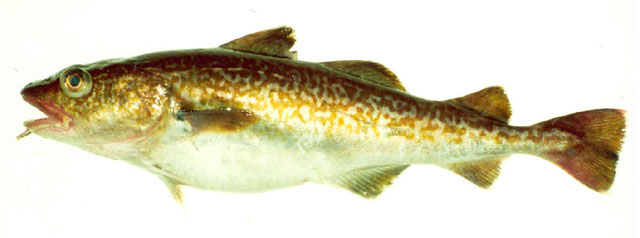| Gadidae (Cods and haddocks) |
| 119 cm TL (male/unsexed); max.weight: 23 kg; max. reported age: 25 years |
|
demersal; brackish; marine; depth range 10 - 1280 m, oceanodromous |
| Arctic: Chukchi and Beaufort Seas eastward across Arctic Canada to western Greenland; south in the Atlantic Ocean to Gulf of St. Lawrence. Pacific Ocean: eastern Pacific to southern California at Santa Monica, and in the western Pacific to the Yellow Sea. |
|
Dorsal spines (total): 0-0; Dorsal soft rays (total): 37-57; Anal spines: 0-0; Anal soft rays: 31-42; Vertebrae: 49-55. Distinguished by the presence of 3 dorsal and 2 anal fins, a long chin barbel (about 3/4 as long as the eye diameter in young, longer than eye diameter in adults), and a space between the second and third dorsal fins that is shorter than the eye diameter (Ref. 27547). Lateral line with a prominent arch under the 1st and 2nd dorsal fins, is straight toward the tail, ending under the 3rd dorsal (Ref. 27547). Brown or gray dorsally, becoming paler ventrally; dark spots or vermiculating patterns on the sides (Ref.1371). Yellow color phases are known (Ref. 27547). Fins dusky; dorsal, anal and caudal fins with white edges that are wider on anal and caudal than on dorsal (Ref. 27547). |
| Found mainly along the continental shelf and upper slopes (Ref. 1371). Form schools (Ref. 9988). They appear to be indiscriminate predators upon dominant food organisms present (Ref. 1371). Young probably feed on copepods and similar organisms (Ref. 27547). Adults feed on fishes, octopi, and large benthic and benthopelagic crustaceans (Ref. 1371); also worms. Parasites of the species include sealworm (Phocanema decipiens) in flesh, copepod (Lernaeocera branchialis) on gills and cestode (Pyramicocephalus phocarum) in the intestine (Ref. 5951). Marketed fresh and frozen for human consumption (Ref. 2850), and also dried or salted and smoked (Ref. 9988). Eaten steamed, fried, broiled, boiled, micro-waved and baked (Ref. 9988). Used in Chinese medicine (Ref. 12166). Minimum depth from Ref. 054440. |
|
Not Evaluated (N.E.) Ref. (130435)
|
| harmless |
Source and more info: www.fishbase.org. For personal, classroom, and other internal use only. Not for publication.

